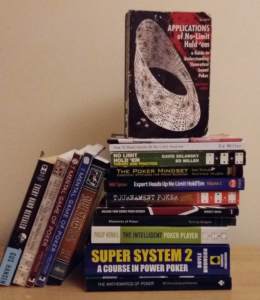Do you get frustrated playing poker tournaments? You play all the time and it seems like you never cash. And even when you do, you cash the minimum. Every once in a while you get teased with a deep run only to run Kings into Aces – resulting in another broken mouse.
Expressed as a ratio this would be 3-to-1 odds, meaning we'll win once every 4 times. In percentage terms the pot odds can be expressed as 25%. Our drawing odds are 31.9%. Since the pot is offering us better odds than our draw, we should call the $12 bet. If you begin to ignore pot odds because you are in a poker tournament, you will.
If only two players are remaining in a Texas Hold'em Poker hand before the flop, the odds of one player winning can range from 5% up to 95%. We have listed the most important preflop match-up probabilities and poker odds below. Poker hands odds & outs: a crash course-guide on poker odds, pot odds, probabilities & odds charts so you can win at Texas Hold'em at the tables or online. One of the most important things that a poker player should know is what their poker odds are in a given situation. There are no betting lines to choose from in poker like you get in the sportsbook or on a racing form, so.
Well as you gain experience, you learn that in order to be successful as a poker player you need to get comfortable with running bad. This is even more prevalent if you are a poker tournament specialist. But no matter how experienced you are, these bad runs can test you and make you question your skill level. This is especially true if you are an amateur poker player who only plays a handful of tournaments a week. You can actually go months without cashing and this duration of time in between cashes can skew your view of reality and affect your play.
Now if you read enough poker forums and websites you will hear about all the online tournament pros who are regularly taking down five and six-figure cashes. They paint this picture of guys constantly making final tables and raking in mounds of cash. You may even be a bit jealous and wonder, 'what do those guys have that I don't?' Well, I'm hoping this article will help answer that question and provide some much needed perspective on the topics of volume and variance.
Amateur Poker Players vs. Pros
Amateurs – For the purpose of this article, an amateur player is someone who plays about 1-3 times per week, usually at night. They have a 'real job' and may have a family or are in college full time, so they can only put in part-time hours. But make no mistake, this player is serious about the game and spends time on poker forums, watching training videos, etc. Since we're talking about tournament poker, the amateur in this article plays mostly large field no-limit hold'em tournaments. They may be a winning player, break even or maybe a slight loser in the game thus far in their career.
Pros – A professional is someone who plays online poker for their sole source of income. For this article, we are using those who specialize in large field online poker tournaments.
The Stats
Before reading too deep into these numbers, keep in mind that the purpose of this article is to provide perspective into your own results by comparing them to the results of other players. It is not meant to be a scientific study.
The numbers below represent an average of 10 players from each category and use results from both Full Tilt Poker and PokerStars from 2010. The pro stats were taken from 1/1/10 until 8/22/10 and the amateur stats were taken from 1/1/10 until 9/20/10. They only include tournaments with over 180 players.
| Pros* | Amateurs* | |
| # Played | 3557 | 661.5 |
| Avg Played/Day** | 21.5 | 3.58 |
| In the Money | 13.10% | 15.7% |
| Final Tables | 3.13% | 2% |
| Top 3 | 1.36% | 0.54% |
| Top 3 when at Final Table | 43.61% | 28.09% |
| Wins | 0.73% | 0.22% |
| ROI | 77.65% | 19.68% |
| Longest Non-Cash Streak | 47 | 22.5 |
* Pro stats were taken from a ranking of the top 10 online tournament players. Amateur stats were taken from a sample of 10 amateur players who volunteered their screen name for use in this study.
**Avg. Played/Day is based on a 5 day week, but also only includes playing 2 sites. Actual volume per day may be larger for those who play more than 2 sites and less than 5 days a week.
What Do These Stats Mean?
As you can see, the pros are not these mythical beasts who cash all the time and final table every tournament. Media attention can sometimes give off a false reality as it only highlights their wins and never mentions how many losses it took to get there.

The realities are:
- Even the top pros only win tournaments less than 1% of the time. For some it was as low as 0.60%. So this means they are winning only 1 out of every 100 times. Of course variance doesn't always come on schedule and they can go 200-300 tournaments without a win.
- Top pros only final table around 3% of the time. Some are as low as 2%.
- Top pros are only cashing about 13% of the time. This means they lose money 87% of the time they play! In fact, amateurs cash more often than pros. The difference is that when pros do cash, they cash deep more often.
- Pros have massive downswings like everyone else. In fact, becasue of the volume they play, they have had longer non-cash streaks.
Why have the pros averaged a $400,000 profit this year before September? It is in their ability to close tournaments. There is a reason why their ROI is 58% higher. Let's look at the stats:
Youtube Poker Tournaments

Free Poker Tournaments

- Pros make 1/3 more final tables than amateur poker players.
- At a 9 person final table, the average of hitting top 3 should be 33%. Pros are hitting this 43.61% of the time.
- Of the times they cash, pros are final tabling almost twice as often as amateurs (23.9% compared to 12.8%).
- Pros finish in the top 3 almost 3x as often as amateurs.
- Volume, volume, volume. Let's not forget that pros play all day, every day. This is their job. They have a distinct advantage of overcoming bad variance much quicker and also seeing 'the long run' of making profitable decisions quicker.
Keep in mind that the group of amateurs used were volunteers from various poker forums. While not all were winning players, the fact that they study the game says they likely have better results than an average amateur. Also, because of their volume size an individual amateur's skills may be better or worse than their results show.
Improving Your Game
How can you use these stats to improve your game?
Add More Tables
Get outside of your 1-3 tabling comfort zone and simply add a couple more tables. I know the argument is that it's harder to make reads, but the volume you put in will make up for that. In addition, this extra volume means you are playing more hands and will result in improving your game even faster. This extra experience will more than make up for the short-term loss of a perfect read.
Play More Days
Just try to add 1 more day per week. Don't be lazy. If you currently play 7 tournaments a day, adding 1 more day x 52 weeks = 364 more tournaments/year. Even at the amateur ROI average above of 20% and average buy-in of $30, that means an extra $2,184 in profit.
Stop Caring About Individual Tournaments
It's easy to expend emotional energy in any single poker tournament. You're trying to win of course. But the odds are that you're not going to. In fact, you're only going to cash about 15% of the time. All you can do is focus on making good decisions and the variance will work itself out in the end.
Play for the Win
There's a reason why amateurs cash more than pros. They care more about it and tighten up near the bubble. But you will miss out on valuable opportunities to accumulate chips if you are playing just to cash. In addition, you can't fear busting or making a mistake when you get deep. In order to make real money playing poker tournaments, you have to trust your instincts and play to win.
If you've ever grown frustrated playing poker tournaments, don't sweat it. Keep in perspective that even the best players in the world don't win that often. The only way to balance out negative variance is to put in enough volume where your skill can prevail.
Good luck at the tables.
Related Articles
By Donovan Panone
Donovan started playing poker in 2004 and is an experienced tournament and cash game player who has a passion for teaching and helping others improve their game.

The realities are:
- Even the top pros only win tournaments less than 1% of the time. For some it was as low as 0.60%. So this means they are winning only 1 out of every 100 times. Of course variance doesn't always come on schedule and they can go 200-300 tournaments without a win.
- Top pros only final table around 3% of the time. Some are as low as 2%.
- Top pros are only cashing about 13% of the time. This means they lose money 87% of the time they play! In fact, amateurs cash more often than pros. The difference is that when pros do cash, they cash deep more often.
- Pros have massive downswings like everyone else. In fact, becasue of the volume they play, they have had longer non-cash streaks.
Why have the pros averaged a $400,000 profit this year before September? It is in their ability to close tournaments. There is a reason why their ROI is 58% higher. Let's look at the stats:
Youtube Poker Tournaments
Free Poker Tournaments
- Pros make 1/3 more final tables than amateur poker players.
- At a 9 person final table, the average of hitting top 3 should be 33%. Pros are hitting this 43.61% of the time.
- Of the times they cash, pros are final tabling almost twice as often as amateurs (23.9% compared to 12.8%).
- Pros finish in the top 3 almost 3x as often as amateurs.
- Volume, volume, volume. Let's not forget that pros play all day, every day. This is their job. They have a distinct advantage of overcoming bad variance much quicker and also seeing 'the long run' of making profitable decisions quicker.
Keep in mind that the group of amateurs used were volunteers from various poker forums. While not all were winning players, the fact that they study the game says they likely have better results than an average amateur. Also, because of their volume size an individual amateur's skills may be better or worse than their results show.
Improving Your Game
How can you use these stats to improve your game?
Add More Tables
Get outside of your 1-3 tabling comfort zone and simply add a couple more tables. I know the argument is that it's harder to make reads, but the volume you put in will make up for that. In addition, this extra volume means you are playing more hands and will result in improving your game even faster. This extra experience will more than make up for the short-term loss of a perfect read.
Play More Days
Just try to add 1 more day per week. Don't be lazy. If you currently play 7 tournaments a day, adding 1 more day x 52 weeks = 364 more tournaments/year. Even at the amateur ROI average above of 20% and average buy-in of $30, that means an extra $2,184 in profit.
Stop Caring About Individual Tournaments
It's easy to expend emotional energy in any single poker tournament. You're trying to win of course. But the odds are that you're not going to. In fact, you're only going to cash about 15% of the time. All you can do is focus on making good decisions and the variance will work itself out in the end.
Play for the Win
There's a reason why amateurs cash more than pros. They care more about it and tighten up near the bubble. But you will miss out on valuable opportunities to accumulate chips if you are playing just to cash. In addition, you can't fear busting or making a mistake when you get deep. In order to make real money playing poker tournaments, you have to trust your instincts and play to win.
If you've ever grown frustrated playing poker tournaments, don't sweat it. Keep in perspective that even the best players in the world don't win that often. The only way to balance out negative variance is to put in enough volume where your skill can prevail.
Good luck at the tables.
Related Articles
By Donovan Panone
Donovan started playing poker in 2004 and is an experienced tournament and cash game player who has a passion for teaching and helping others improve their game.
Great, revealing article. Stats like these are very encouraging. Thanks, Donovan
Leave a Reply
You must be logged in to post a comment.
On This Page
Introduction
To use this calculator, enter the amount of each chip stack, and optionally any prize money for each place. If there are fewer than nine players, leave the last player positions empty. For example, if there are five players, fill in stack amounts for players 1 to 5 only. Do not skip positions, or you will get nonsensical results. Then click 'calculate.'The program will calculate the probability of each player finishing in each possible position, as well as his expected share of the prize pool.
Player Stacks:
